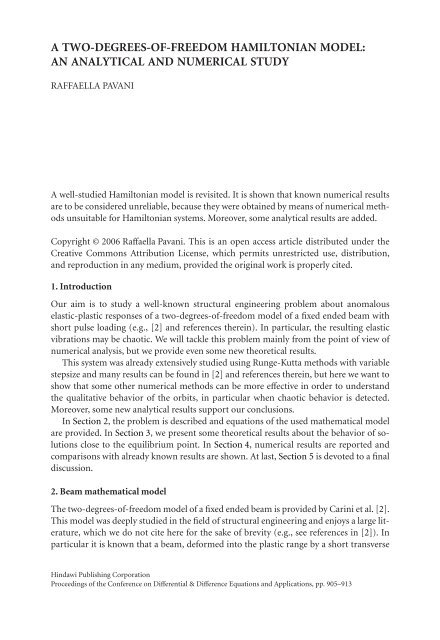DIFFERENtIAl & DIFFERENCE EqUAtIONS ANd APPlICAtIONS
DIFFERENtIAl & DIFFERENCE EqUAtIONS ANd APPlICAtIONS
DIFFERENtIAl & DIFFERENCE EqUAtIONS ANd APPlICAtIONS
You also want an ePaper? Increase the reach of your titles
YUMPU automatically turns print PDFs into web optimized ePapers that Google loves.
A TWO-DEGREES-OF-FREEDOM HAMILTONIAN MODEL:<br />
AN ANALYTICAL AND NUMERICAL STUDY<br />
RAFFAELLA PAVANI<br />
A well-studied Hamiltonian model is revisited. It is shown that known numerical results<br />
are to be considered unreliable, because they were obtained by means of numerical methods<br />
unsuitable for Hamiltonian systems. Moreover, some analytical results are added.<br />
Copyright © 2006 Raffaella Pavani. This is an open access article distributed under the<br />
Creative Commons Attribution License, which permits unrestricted use, distribution,<br />
and reproduction in any medium, provided the original work is properly cited.<br />
1. Introduction<br />
Our aim is to study a well-known structural engineering problem about anomalous<br />
elastic-plastic responses of a two-degrees-of-freedom model of a fixed ended beam with<br />
short pulse loading (e.g., [2] and references therein). In particular, the resulting elastic<br />
vibrations may be chaotic. We will tackle this problem mainly from the point of view of<br />
numerical analysis, but we provide even some new theoretical results.<br />
This system was already extensively studied using Runge-Kutta methods with variable<br />
stepsize and many results can be found in [2] and references therein, but here we want to<br />
show that some other numerical methods can be more effective in order to understand<br />
the qualitative behavior of the orbits, in particular when chaotic behavior is detected.<br />
Moreover, some new analytical results support our conclusions.<br />
In Section 2, the problem is described and equations of the used mathematical model<br />
are provided. In Section 3, we present some theoretical results about the behavior of solutions<br />
close to the equilibrium point. In Section 4, numerical results are reported and<br />
comparisons with already known results are shown. At last, Section 5 is devoted to a final<br />
discussion.<br />
2. Beam mathematical model<br />
The two-degrees-of-freedom model of a fixed ended beam is provided by Carini et al. [2].<br />
This model was deeply studied in the field of structural engineering and enjoys a large literature,<br />
which we do not cite here for the sake of brevity (e.g., see references in [2]). In<br />
particular it is known that a beam, deformed into the plastic range by a short transverse<br />
Hindawi Publishing Corporation<br />
Proceedings of the Conference on Differential & Difference Equations and Applications, pp. 905–913

















